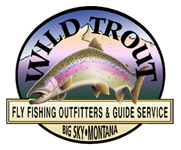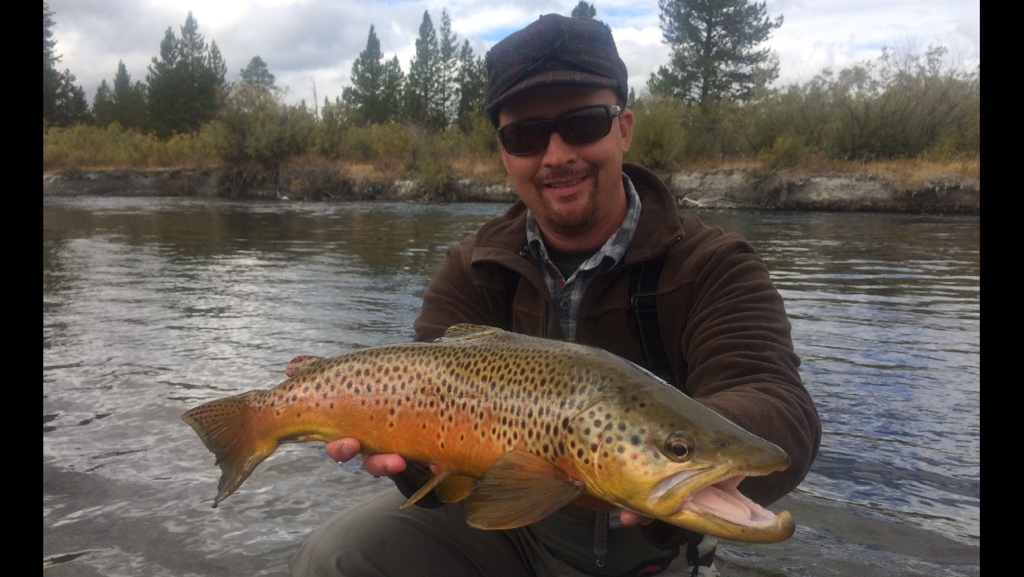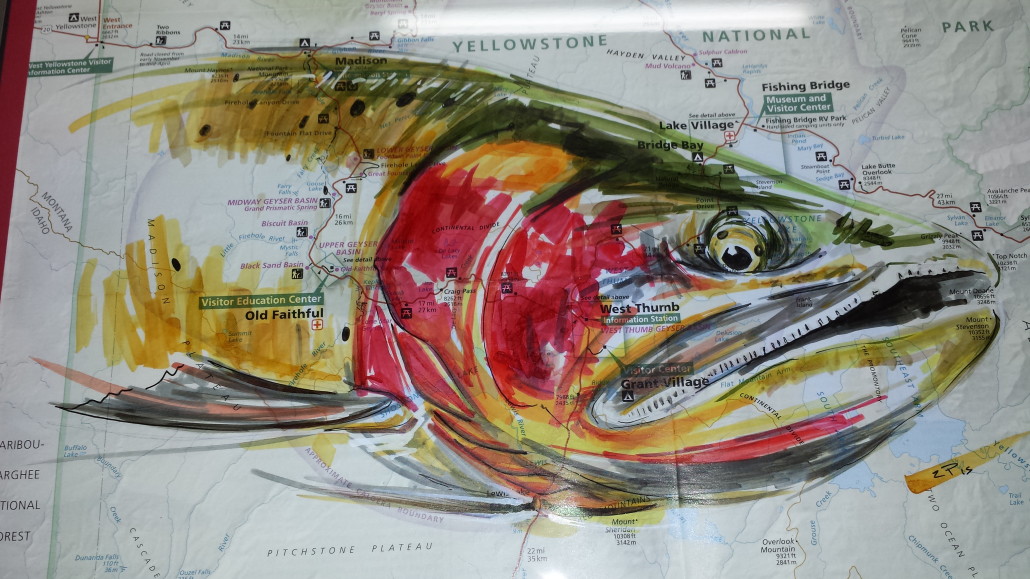GALLATIN RIVER FISHING REPORT
The Gallatin is settling into fall mode with cool water temperatures, diminished fishing pressure, and a productive bite from mid-morning on. Baetis are hatching in good numbers throughout the canyon and upper river on overcast afternoons.
She’s low and clear, but the Gallatin came through the summer season in fine shape. Water temperatures have dropped substantially over the past couple of weeks due to longer nights and a couple of cold fronts that have moved across the state. With the colder water temperatures the early morning hours have been less and less productive. If you do find yourself out early, try to focus on stretches of the river that receive the inflow of spring water, which helps to moderate the river’s water temperature in those reaches. Snowflake Springs is one such reach of river, as is the upper end of the canyon.
We’ve been seeing good hatches of fall baetis over the past week or so, with the best emergences occurring on calm, overcast afternoons. A size 20 Sparkle Dun is typically all you need to imitate these little mayflies, but having a couple of CDC dun and emerger patterns on hand can make all the difference at times. Spend a day on the water right now and you’re likely to see a few October caddis bouncing around… a size 10 orange Stimulator fished blindly through likely holding water can be productive.
The nymph bite remains steady, with the usual suspects… small baetis and midge patterns are still our top producers. Eggs are back on the menu as well now that the river’s whitefish population is spawning.
Streamers are taking fish consistently now too, with mid-morning and evening being most productive – cloud cover can extend the bite. While we’ve seen some success on big, articulated patterns the best action has been with smaller sculpin and baitfish patterns… think Bow River Bugger, McCune’s Sculpin, Sparkle Minnow, Kreelex, Clouser, and Home Invader.
Give us a call today to book a day with one of our professional guides on the blue-ribbon waters of the upper Gallatin River.
Dries: Sparkle Dun (Olive) #18-20, Adams #18-20, Parachute Adams #18-20, Purple Haze #18-20, Stimulator (Orange) #10-12, Grand Hopper #12
Nymphs: RS-II (Grey) #18-20, Little Green Machine #18-20, Pheasant Tail #16-20, Soft-Hackle Pheasant Tail #16-18, Soft-Hackle Hare’s Ear #16-18, Lightning Bug #16-18, CDC Emerger #14-18, Shop Vac #16-18, Serendipity (Red/Crystal) #16-18, Zebra Midge (Black/Olive) #18-20
Streamers: Sparkle Minnow #4-6, Bow River Bugger #4-6, Home Invader #2-6, McCune’s Sculpin#4, Gonga #4. Be sure to have an array of colors represented in your streamer box including: white, yellow, olive, natural/tan, and black.
UPPER MADISON FISHING REPORT
The upper Madison is fishing well, flows are low and fishing pressure is light. The walk and wade stretch has been most consistent, but the float stretch has certainly had its moments.
After a busy August, the upper Madison is getting some relief. The number of local anglers is thinning out as their attention increasingly turns to the honored fall pastimes of pursuing birds, bucks, and bulls. Non-resident anglers are few and far between and those who are wise enough to have planned a fall trip to Montana are largely focused on the portion of the Madison River within Yellowstone National Park. Below Quake Lake anglers now have plenty of elbow room, whether setting out afoot in the vicinity of $3 Bridge or floating below Lyons.
Baetis are hatching in good number river wide, and predictably the best emergences are occurring during early to mid-afternoon under calm, overcast skies. There are also enough October caddis around to garner the attention of trout, and searching with a size 10 Stimulator can pay dividends. Terrestrial activity has waned, but smaller hopper patterns are taking fish at times… it’s certainly worth keeping them in the rotation, just don’t run with it for too long if you’re not seeing results.
The nymph bite is solid with patterns that still lean toward the smaller end of the spectrum (#16-18) and that imitate baetis and midges. We have been seeing increased activity on stonefly patterns lately as well, with a variety of Rubber Leg colors taking fish. Some old school patterns such as the Half Back and Carey’s Special have been producing as well.
But it seems that most folks out on the upper right now are focused almost exclusively on streamers, and for good reason – they’re moving fish consistently. Now is the time to start throwing the big, articulated stuff. Work the banks, but be sure to also spend some time picking apart the belly of the run as well as tailouts and around in-stream structure such as boulders. White and olive have been top producers, but yellow has had its moments and black is always worth a shot, particularly on days with dark, nasty weather or during low-light periods.
Call today to book a float trip on the world-famous upper Madison River.
Dries: Sparkle Dun (Olive) #18-20, Adams #18-20, Parachute Adams #18-20, Purple Haze #18-20, Stimulator (Orange) #10-12, Grand Hopper #12
Nymphs: Pats’ Rubber Legs #8, Mega Prince #8, Pheasant Tail #16-18, Soft-Hackle Lightning Bug #16-18, Lightning Bug #16-18, Shop Vac #16-18, Serendipity (Brown/Red) #16-18, Crystal Dip #16-18, Anato-May #16, Military May #16, Hogan’s S&M #18, Transitional Dun #16-18, San Juan Worm (Purple) #12
Streamers: Sex Dungeon #4, Circus Peanut #4, Barely Legal, Sparkle Minnow #4-6, Bow River Bugger #4-6, Home Invader #2-6, McCune’s Sculpin#4, Gonga #4. Be sure to have an array of colors represented in your streamer box including: white, yellow, olive, natural/tan, and black.
YELLOWSTONE RIVER FISHING REPORT
The Yellowstone River has largely been re-opened to fishing, but some closures remain in place – be sure to check with Montana Fish, Wildlife and Parks for the latest before heading out.
The Yellowstone River and its tributaries have largely been reopened to fishing, but the portion of the river through Paradise Valley from Emigrant Fishing Access Site downriver to Pine Creek Fishing Access Site remains closed to fishing while biologists and fisheries managers continue to monitor the fishery.
The river has been fishing well, particularly with streamers… swung, stripped, dead-drifted… it’s all producing. The hopper bite has slowed, but small, tan hopper patterns have been very productive at times – the action is spotty though. During baetis emergences there have been a lot of heads up in the back eddies – a simple Parachute Adams or Sparkle Dun in size 18 to 20 will do the trick.
Give us a call to book a fall float trip on the legendary big fish water of the Yellowstone River.
Dries: Sparkle Dun (Olive) #18-20, Adams #18-20, Parachute Adams #18-20, Purple Haze #18-20, Stimulator (Orange) #10-12, Grand Hopper #12
Nymphs: Pats’ Rubber Legs #8, Mega Prince #8, San Juan Worm (Red) #12, CDC Pheasant Tail #16-18, Pheasant Tail #16-18, Lightning Bug #16-18, Copper John #14-16, Beadhead Yellow Sally #14, CDC Emerger #14-18, Shop Vac #16, Serendipity (Red/Crystal) #16-18.
Streamers: Sex Dungeon #4, Circus Peanut #4, Barely Legal, Sparkle Minnow #4-6, Bow River Bugger #4-6, Home Invader #2-6, McCune’s Sculpin#4, Gonga #4. Be sure to have an array of colors represented in your streamer box including: white, yellow, olive, natural/tan, and black.
YELLOWSTONE NATIONAL PARK FISHING REPORT
The west side rivers are once again playing host to a strong fall run of brown and rainbow trout migrating up from Hebgen Lake. The Madison, Firehole and Gibbon are all producing runners, the number increasing by the day.
The Hebgen fish have arrived, their numbers still pale in comparison to what we’ll be seeing a month from now, but it’s definitely GAME ON! The Madison, Firehole, and Gibbon Rivers are all producing fall-run fish, but the majority of the runners are still pretty low in the system… down in the vicinity of Bakers Hole and the Barns Pools. Fishing pressure is still relatively light, it’s a great time to be out on these rivers. Fall baetis hatches have fish looking to the surface, but the bulk of the action has been on nymphs, soft hackles and streamers with nymphing anglers taking the majority of fish on a variety of patterns including stonefly and baetis nymphs along with worm and egg patterns.
Give us a call (800-423-4742) to discuss planning your own trip to fish Yellowstone National Park this fall.
Dries: Sparkle Dun (Olive) #18-20, Adams #18-20, Parachute Adams #18-20, Purple Haze #18-20, Stimulator (Orange) #10-12, Grand Hopper #12
Nymphs: Pheasant Tail #18-20, Soft-Hackle Pheasant Tail #18-20, CDC Emerger #18-20, Partridge & Olive Soft Hackle #18-20, Lightning Bug #18-20, WD-40 #18-20, RS-2 #18-20, Pat’s Rubber Leg #8, San Juan Worm (Red, Pink, Purple) #12, Glo-Bug (Pink, Salmon, Orange) #12




